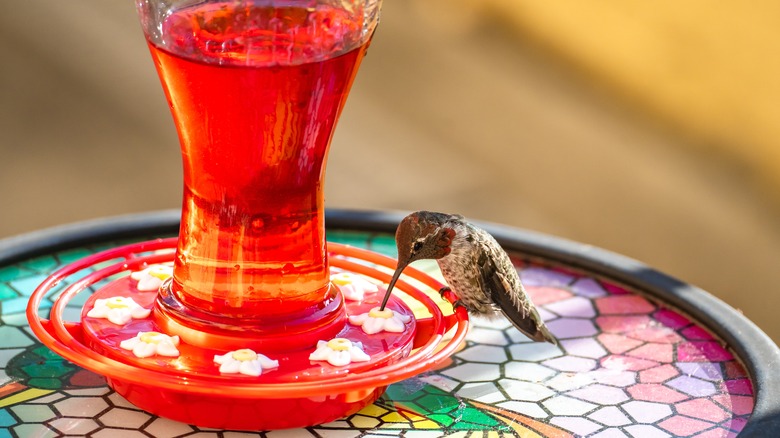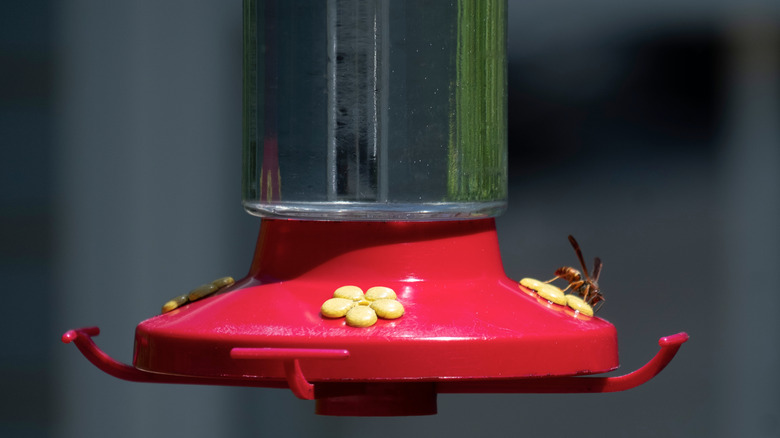We may receive a commission on purchases made from links.
Few homeowners are unhappy if they spot a hummingbird flitting about their garden. Many of us enthusiastically hang a nectar-filled feeder near a window or under a porch roof, hoping that a few bejeweled birds will visit. The more hummingbird feeders you hang around your garden, the more birds you’ll see, right? The short answer is that it’s … complicated. Yes, you’ll be able to feed more hummingbirds, but there are other surprising benefits like reducing fighting between territorial males. However, we’d be remiss if we didn’t mention the downsides, as more feeders can attract more pests and predators. You also may not need to hang multiple feeders year-round.
Knowing hummingbird life cycles — including breeding and migration patterns — can help determine if and when to hang more feeders. Hummingbirds arrive in the spring in most parts of the United States, though some species stay year-round in warmer states. As the nesting season in the spring progresses, adult male hummingbirds — especially ones of the Rufous species — become highly territorial, scaring off the competition for mates and food sources. This means that adding more feeders during the spring and summer may be beneficial, as more birds will be able to feed even if the males are territorial, while you can keep up less during the fall and winter months when the birds are migrating.
How to include multiple feeders in your yard

Given the hummingbird’s penchant for bullying, adding multiple smaller feeders that have 8 to 16 ounces of nectar capacity during the spring and summer will cater to more hummingbirds than a couple of large ones. Amazon has the Birds Choice 8-ounce glass feeder with eight ports for about $20. Or, buy an American-made 16-ounce plastic hummingbird feeder with 10 ports for about $10 from First Nature. Seven feeders may be the maximum for most backyards.
Fill your feeders, then hang them anywhere from 6 to 20 feet apart and out of sight from one another. Position them near perches like overhanging tree branches to give somewhere for birds to wait their turn. A single hummingbird needs to eat every 15 minutes or less to meet their energy requirements, so that’s a lot of feeders that can be visited in a day! Don’t have enough space for multiple hummingbird feeders in your small backyard or condo balcony? Encourage your neighbors to hang feeders, too. Summertime is fledgling time, so more feeders will cater to more birds, but as winter migration starts in late summer to early fall, numbers will naturally decline. You can take down all your hummingbird feeders at this time or leave one out for stragglers or early next-season arrivals.
Precautions to using multiple hummingbird feeders

However, before installing multiple feeders in your backyard, ensure you can adequately maintain them. You need to regularly and safely clean your hummingbird feeders to keep bird visitors healthy. Sometimes, hummingbirds prefer one style of feeder over another or familiar ones over newer additions. In this case, take down the newest feeders and try them again at a later date or test them in a different location. Additionally, everything from other nectar-loving birds to wasps to bears may try to access the sugar water. Having more than one feeder hanging in various spots in your garden will ensure there’s always at least one for hummingbirds to use. Also ensure that the feeders are high enough off the ground that predators like cats can’t reach them but still low enough that you can.
Occasionally, multiple bird feeders won’t lead to more feathered friends. Shawna Coronado, a blogger and passionate amateur gardener, was thrilled to have a single hummingbird visit her garden. She wanted more, so she put out five feeders as an experiment. By fall, her yard still hosted just one fluttering friend. If this happens to you, don’t feel disheartened, just tweak your approach. Experiment with different feeder styles, try a new nectar recipe or brand, and plant more flowers that hummingbirds absolutely love.



